Wallace Fakes Revisited
Posted by: Loren Coleman on January 9th, 2007
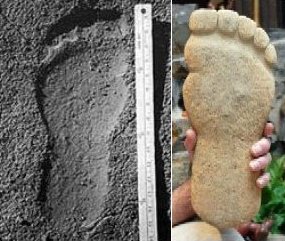
Mark Hall has posted a review entitled "When Legends Meet Science" via his "Living Fossils" page at Wonders about Jeff Meldrum’s new book, Sasquatch: Legend Meets Science.
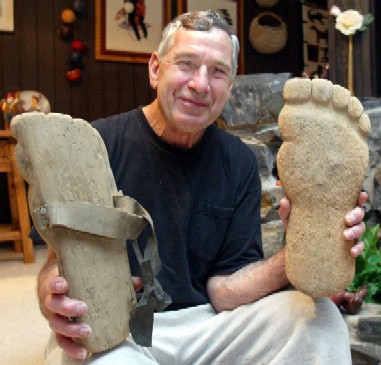
Dave Rubert photographs of the Ray Wallace fake Bigfoot footprint tools.
One section of Mark Hall’s review discusses the Ray Wallace wooden fake track creations, and how the imprints made from them are still appearing in works by some Sasquatch researchers.
Hall writes:
[Jeff] Meldrum fails to recognize that the Ray Wallace fake imprints have become part of his database. For a professional claiming an expertise in the study of footprints, this lapse is a costly and tragic error. He had a chance to rid himself of this pollution, but he has failed to do so.
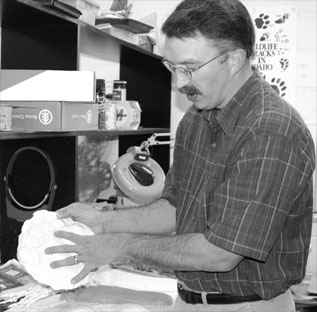
Meldrum did not have to uncover the fakery on his own. The history of how these fakes came into being has already been told. The hoaxing tools were publicly displayed in December of 2002 after Ray Wallace died. I was one who wanted to know how these fakes had found their way into so many places. They appeared in Sanderson’s 1961 book and in many popular books and articles since that time.
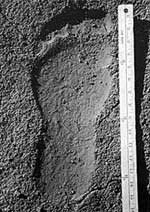
When it was shown that these were hoaxed impressions, it became important to throw out the trash and leave us with valid data. So I reviewed the records for the 1950s and 1960s. I published an article that came out in April of 2003 that illustrated the three sets of fake feet that were associated with Ray Wallace. I followed up with two more articles as more of the history of hoaxing emerged.* Meldrum has failed to learn the history and throw out the garbage.
Perhaps he has been unduly influenced by those who were also fooled by Ray Wallace and cannot acknowledge their mistakes. But Meldrum is not an amateur investigator. According to the publicity for this book he has even been given a grant of $30,000 to further his studies of the phenomenon. He should be leading the effort to throw out the bad data. Instead we find him defending the fakes.
In Legend Meets Science he illustrates only one of the most prominent of the wooden tools used, the right foot. It is the wooden tool for the left foot that produced the most often photographed images. It shows up in widely published cases of trackways seen in California. It has been cast in plaster, despite Meldrum’s assertion that it has not**. Those who cannot admit to this particular success by Ray Wallace have kept this tool out of the books they continue to publish, and Meldrum has taken the same sorry path by illustrating only one of the two wooden tools.
Keep these shortcomings in mind if you read this book.
^^^^^^^
* "The Real Bigfoot and Genuine Bigfoot Tracks" in Wonders, Volume 7, pages 99-125.
"The Bigfoot Community’s Wallace Problem" in Wonders, Volume 8, pages 44-53.
"October 1958 in the History of Bigfoot" in Wonders, Volume 9, pages 85-96.
– Mark A. Hall
**Further clarification/footnote from Hall: Meldrum does show a cast of the left tool on his page 68. But it is a lousy cast [thus allowing Meldrum to] say it doesn’t match. It was made by the tool and the cast shown beside it was a fake in the 13-inch size. But the medium at that location was good for imprints and not for making casts.

Click on the wooden fakes to make them bigger.
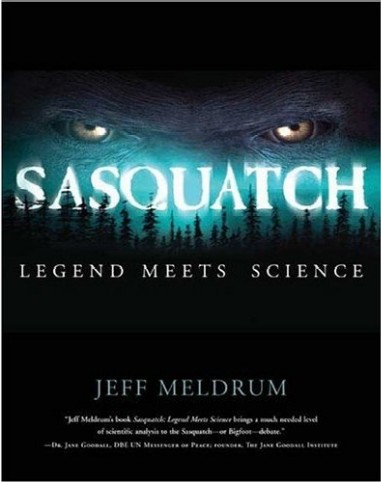
Sasquatch: Legend Meets Science by Jeff Meldrum.
About Loren Coleman
Loren Coleman is one of the world’s leading cryptozoologists, some say “the” leading living cryptozoologist. Certainly, he is acknowledged as the current living American researcher and writer who has most popularized cryptozoology in the late 20th and early 21st centuries.
Starting his fieldwork and investigations in 1960, after traveling and trekking extensively in pursuit of cryptozoological mysteries, Coleman began writing to share his experiences in 1969. An honorary member of Ivan T. Sanderson’s Society for the Investigation of the Unexplained in the 1970s, Coleman has been bestowed with similar honorary memberships of the North Idaho College Cryptozoology Club in 1983, and in subsequent years, that of the British Columbia Scientific Cryptozoology Club, CryptoSafari International, and other international organizations. He was also a Life Member and Benefactor of the International Society of Cryptozoology (now-defunct).
Loren Coleman’s daily blog, as a member of the Cryptomundo Team, served as an ongoing avenue of communication for the ever-growing body of cryptozoo news from 2005 through 2013. He returned as an infrequent contributor beginning Halloween week of 2015.
Coleman is the founder in 2003, and current director of the International Cryptozoology Museum in Portland, Maine.











I would rather know the truth, even when that truth contradicts long-held beliefs.
If Dr. Meldrum’s database does contain fake images he should ruthlessly eliminate them.
That in no way invalidates his research; on the contrary, holding evidence to a very high standard of integrity will only strengthen it.
I have to admit: I have always found something rather fishy about the ruler-measured track above, which I believe is dubbed, in “Meet the Sasquatch,” one of the best photos ever taken of a Bigfoot print.
It always looked, I don’t know, a little too neat.
We’re the most wide-ranging imitators in the animal kingdom. What makes the search for the sas such a minefield — and me, in the face of all the evidence, still a skeptic — is that there is almost no piece of evidence that can’t be faked, on its own, pretty well.
Although if you have a video of one doing away with your prize bulls and heifers, I stand corrected.
And of course I see the need to add this: there hasn’t been significant debunking done on sas tracks, given all the ones that are out there.
Debunking one means nothing.
But it “looks” fake, not made by a flexing foot.
I guess I don’t understand what Hall is talking about. I read Meldrum’s book and he discusses Wallace’s fake carved feet at length, and has pictures of at least the top one.
Fake feet fiasco frustrate fact finding for furry friends.
Maybe I’ll hold off on buying this book for now. Too many of these books that claim the “scientific” angle are pretty one sided. Now, if someone like Matt Bille were to write a book on bigfoot, then I’d be more interested.
Regarding jayman’s comment above, here is Mark Hall’s response:
Among the record of imprints that look like the Ray Wallace wooden tools are the Blue Creek Mountain Road impressions from 1967. Meldrum does not recognize them as such. The most telling of the wooden tools is the one that made “left foot” impressions. It is not illustrated in Meldrum’s book, while the “right foot” tool is reproduced eight times.
Please type in “Wallace” in the search engine, above right, to read more on Cryptomundo about the Ray Wallace hoaxing. The issue in general and the Blue Creek Mt Road tracks have been debated on other threads before and there’s more info there on this issue.
Thank you.
I acknowledge what Mark Hall is trying to point out in his review but does it REALLY matter to the average lay-person who has or is reading Meldrum’s fine book? It may or may not. If perchance they notice this i.e.,”pollution” as Hall puts it I doubt they’re going to lose any sleep over it so to speak. I certainly haven’t.
I guess I’m still confused about “left foot tool” vs. “right foot tool”. Isn’t the illustration at the top a “left foot tool” because it produces a left print? While I don’t have Meldrum’s book in front of me at the moment I’m sure he has this object in there. The double indentation on the inner edge was very well known. This hard, rigid artifact produces a “cookie cutter” print with none of the signs of a flexible, living foot, as would any carved wooden foot.
Deejay, if you don’t want to spring for Meldrum’s book get it from your local library, or ask the librarian to do an interlibrary loan. Maybe it’s not perfect but well worth reading.
Hall must have gotten a defective copy of Meldrum’s book. My copy has numerous photos of the various fake feet Wallace used, not just one picture, including a photo of a collection of various Wallace fake together. It also has side by side comparison photos of the fake feet with the tracks purportedly made with them. The fakes don’t match the casts.
I’ll be glad to loan my copy to Mr. Hall so he can read the whole book instead of his apparently defective copy.
The Wallace prints problem is symptomatic of much of Meldrum’s “science.” Good scientists distinguish valid evidence from invalid evidence, real from fake. In this and many other examples in “Legend Meets Science,” Meldrum seems unable or unwilling to do so.
Another crystal clear example is Meldrum’s use of Henner Fahrenbach’s “statistical analysis of reported Sasquatch dimensions,” based on a collection of stories and anecdotes which Meldrum HIMSELF admits “may or may not be credible”(!).
That Meldrum–a scientist as he keeps reminding us–would take this sort of information at face value and present it as good science is astounding. Bigfoot research deserves better than this.
The unfortunate things, Ben, are that:
1. In the absence of a holotype, sightings, footprints, hair, video and other less-than-proof are all we have to work with.
2. As the animal is unconfirmed, there’s no way to say FOR SURE what it looks like. Again, sightings are all we have on this, which is why Fahrenbach annotates the analysis as “reported.”
It’s my belief that, if there’s an animal out there, it’s teaching us one hell of a lot about how much we think we know — about everything — compared to how much we really do. And we sure haven’t confirmed it by rehashing old evidence that many have simply refused to go with and never will.
The next thing to do is field research, by professionals with the resources and time to spend in the field. (Not just amateurs who can only donate the occasional weekend if they want to keep a roof over their heads.)
If this is going to happen, where should the pros go? Well, it only makes sense to go where there have been concentrations of good sighting reports by what appear to be reliable witnesses. That IS good science. When something isn’t known, you don’t have the known to go on.
If you ask me, it says a lot for the quality of the reports as evidence that almost anybody could look at a composite sketch, based on all the ones I’ve read, and say yep, that’s what I saw. The consistency on so many points of so many reports is nothing short of remarkable, no matter how you slice it.
Other than that, you’re just waiting for some yahoo in a pickup truck to shoot a Bigfoot. Hasn’t happened yet.
And this I think needs double emphasis, re:
“Good scientists distinguish valid evidence from invalid evidence, real from fake.”
One can’t do this, no matter how good a scientist, if one is working from the current base of information. With a wolverine, you can say what constitutes valid evidence and what doesn’t. Although, as Barry Lopez points out so eloquently in “Of Wolves and Men,” long-term observation of an animal in the wild can yield data that one would have considered totally non-characteristic — if one hadn’t seen it firsthand.
If you don’t even know, for certain, that there is an animal out there, you don’t know what “valid” is. (And you can only pronounce “fake” if you see a trace of artifice clearly left by a human.) You work with what you have.
When the apple fell on Newton’s head, he didn’t consider it valid evidence of the earth’s gravitational field. He said, what the hell?…and took it from there.
Oh. And this requires emphasis too.
Anybody who knows anything about the raft of new species discoveries in Vietnam (maybe the best example) over the past fifteen or so years knows how they happened:
1. Sighting reports by locals.
2. Sketchy scraps of dubious evidence.
3. Full-time, professional, real scientists, following up.
I see DWA has once again managed to avoid addressing my main criticism, that Meldrum is presenting invalid research as good science. I will take that as a tacit admission of my point.
I’m not going to comment further on DWA’s opinions, as from past experience I know it would be fruitless. People like DWA hide behind fake names, posting anonymously, and criticizing any experts and scientists they happen to disagree with while wilfully ignoring any skeptical studies or criticism.
Unlike DWA, I am not afraid to have my name associated with Bigfoot. I have actual academic credentials related to the field, and have done published fieldwork in cryptozoology. Also unlike DWA, I have read extensively on both sides of the topic, not just the one I agree with. Then again, getting both sides to a story has never really been a strong point in cryptozoology.
Ben, come, come now. Stop name calling and belittling, and join us at the table.
No one is afraid to have his name associated with saying the animal doesn’t exist, right? That’s the EASY postion, Ben, not the tough one.
Meldrum is doing good science on the only information available to him. It would be nice if mainstream science got off its duff and did its job on this one, but as a skeptic, I’m not holding my breath.
Not acknowledging my points is what constitutes tacit acceptance. But I know you tacitly accept that. 😉
One more thing, Ben, speaking of bad science.
Drawing conclusions about a skilled opponent’s qualifications based on no information is NOT good science.
As Jeff Meldrum could tell you.
And slagging cryptozoology smacks, just slightly, to me of biting the hand that feeds.
Just an informed observation.
And speaking of reading: Ben, just read my posts. I mean really read them. Your response sounds like a canned reaction to the appearance of your nemesis. I’m no one’s nemesis. And last I checked, I don’t bite. 😀
And here I was trying to make NICE.
🙁
If you were to compare the Wallace wooden foot with the actual cast you would see that the features do not line up. They look similar but the waist is too far back towards the heel and the double ball is off in position as well. Given that these features could of moved while embedded into the soil when making a track and moving somewhat, their relationship within the track would also show this. It does not. It is obvious that the wooden foot of Wallace is not what made the cast.
How about comparing the left wooden foot tool to the left foot imprint/actual footprint, not cast, at the top of this post?
Besides, who says the fake foot that is being compared to the cast noted is the one that goes with that cast. Wallace made several sets of fake feet and how do we know that we have seen them all.
But please look at the photographed track of the left footprint and tell me that is an imprint from a living foot?
The square big toe (hallux) and the peas-in-a-pod look of the rest of the toes are diagnostic of one set of Wallace’s fake wooden feet, indicative of a carving style found in the fake prints, and very apparent in the photographs seen in many books of Wallace Bigfoot fake prints, including even my first Tom Slick book before I came to grips with the reality of the bad apples in the bushel basket.
There are plenty of good tracks to examine, discuss, and analyze, so why persist in have the pranks that Ray Wallace and friends pulled live on? Throw them out.
Ben says above: “I see DWA has once again managed to avoid addressing my main criticism, that Meldrum is presenting invalid research as good science.”
Um, Ben, I’ve hit that one head on in practically my every post. That would be it, your main criticism, far below us, trailing smoke on its way down to the deck.
What is “invalid research”? You’ve never said that, and I think there’s a reason. You don’t think ANY research into this subject is legitimate. What is there to do research ON, Ben, other than reports, also known as sightings, also known as EVIDENCE, and trackways? Unless — and this is funny — it’s yet another rehashing of the Patterson film, or another discussion of another long-beaten-dead-horse trackway that some people will never acknowledge as genuine and some others will never acknowledge as fake.
Science — that’s full time scientists, exercising science’s social responsibility to roll back the unknown — needs to go elsewhere: into the field, for a long-term stay, in areas suggested by heavy concentrations of SIGHTINGS, to find the animal. Or else, Ben, what? It’s clear that any use of any Bigfoot evidence for purposes of analysis is, to you, illegitimate.
Next argument?
Here’s mine. A challenge, to science. Who cares how many subspecies there are of the yellow-bellied red-butted mouse lemur of Madagascar?
Fund something exciting. Do something interesting to more than the pocket-protector set. Find the world’s most spectacular animal, guys! Have you forgotten how to have FUN?